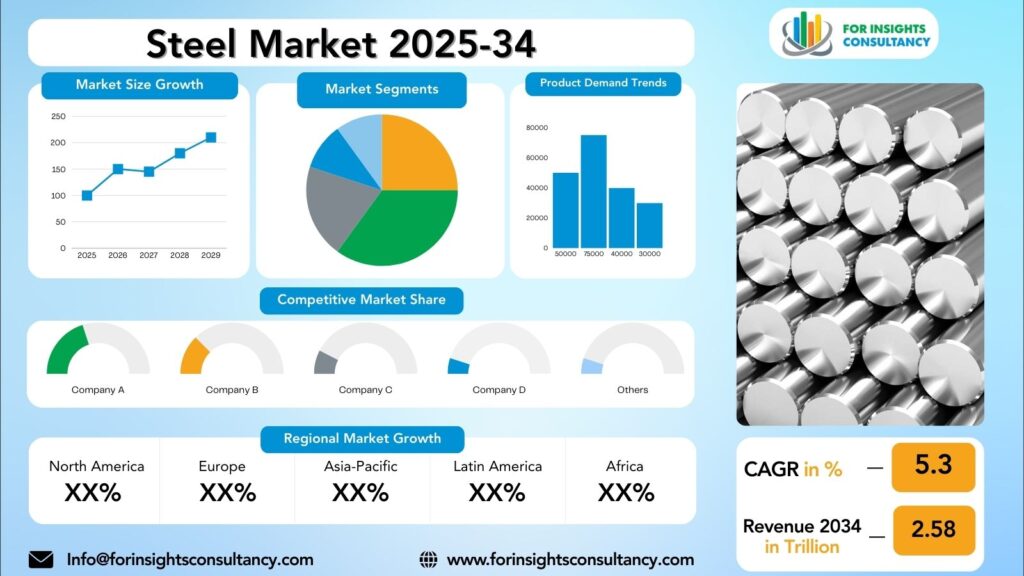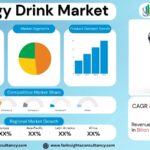
Steel Market Research Report By Product Type (Finished Products, Semi-Finished Products), By Process (Basic Oxygen Furnace (BOF), Electric Arc Furnace (EAF)), by End-User Industry (Construction, Automotive, Machinery, Pipes & Tubes, Consumer Appliances, Other Industries), and Region Global Market Analysis and Forecast, 2025-2034
Aug-2025 Formats | PDF | Category: Manufacturing & Construction | Delivery: 24 to 72 Hours
Steel Market is forecast to increase from USD 1.62 trillion in 2025 to USD 2.58 trillion by 2034, at a CAGR of 5.3%.
Steel Market: A Comprehensive Overview and Future Developments
The steel market is a vital sector in various industries worldwide, including construction, automotive, and manufacturing. Despite fluctuations due to global trade tensions, technological advancements, and consumer demand shifts, the steel market remains resilient, with growing demand in both developed and developing economies. The construction industry is a significant driver of steel consumption, and with rapid urbanization and infrastructure development in emerging markets, the demand for steel in construction projects is expected to remain strong.
Future developments in the steel market include technological advancements and changing consumer preferences. Sustainability and environmental concerns are key trends, with steel manufacturers investing in innovative production methods to reduce carbon emissions and minimize environmental impact. Digitalization and Industry 4.0 technologies are also transforming the steel industry, with automation, robotics, and data analytics revolutionizing production processes. By embracing digital transformation, steel companies can improve productivity, reduce costs, and stay competitive in a rapidly evolving market.
Steel Market Dynamics
Growth Drivers
The steel market’s growth is driven by economic expansion, infrastructure development, technological advancements in steel production, and increasing demand from the automotive and manufacturing sectors. The construction sector is experiencing a surge in steel demand due to investments in infrastructure projects, particularly in emerging economies like Asia and Africa. Technological advancements in steel production, such as electric arc furnaces and continuous casting, have improved efficiency and productivity in steel mills, meeting the growing demands of various industries.
The automotive and manufacturing sectors are also driving demand growth, with increased global vehicle production and lightweighting strategies boosting the demand for advanced high-strength steels. Steel is being used in automotive components and industrial machinery due to its durability, versatility, and cost-effectiveness. Sustainability and environmental regulations are also driving growth in the steel market, with steel manufacturers adopting sustainable practices to reduce their environmental footprint. Recycling and circular economy initiatives are gaining momentum in the industry.
Fluctuations in raw material prices, particularly iron ore and scrap metal, can significantly impact the steel market’s growth. Volatility in commodity prices caused by supply disruptions, geopolitical factors, and market speculation can create challenges for steel manufacturers in cost management and profitability. Monitoring and managing raw material costs are crucial for companies operating in the steel industry.
Restraints
Economic uncertainty is a major constraint on the steel market, as fluctuating economic conditions can lead to unpredictable demand, making it difficult for manufacturers to plan production and adjust inventory levels. This can result in excess supply or shortages, affecting prices and profitability. Environmental regulations, such as those imposed by governments due to climate change, often require significant investments in new technologies and processes, increasing production costs for steel manufacturers.
Trade tariffs and protectionism can also impact the steel market, making foreign steel more expensive for domestic producers but potentially raising prices for consumers. Technological innovation can improve efficiency and reduce costs, but it requires significant capital investment. The steel market is highly competitive, with manufacturers from around the world vying for market share. Low-cost producers in countries with lower labor costs can undercut prices, putting pressure on profitability for manufacturers in higher-cost regions. Competition from alternative materials like aluminum and composites also poses a challenge to the steel industry.
Opportunities
The steel market is experiencing a surge in demand across various sectors, prompting businesses to diversify their product portfolio. Offering specialized steel products for construction, automotive, and energy sectors can boost revenue and attract new market segments. Businesses can differentiate themselves by adopting eco-friendly practices, such as adopting green technologies and promoting recycling, to attract environmentally-conscious customers.
Strategic partnerships and collaborations with other industry players can expand reach, access new markets, and drive innovation. To stay relevant in the digital age, businesses in the steel market should embrace digital transformation, leveraging data analytics, cloud computing, and automation to streamline operations, improve decision-making, and enhance customer experiences. This can help adapt to changing market dynamics and maintain agility in a fast-paced industry.
Challenges
The steel market faces several challenges, including fluctuating raw material prices, shifting demand and supply dynamics, and balancing profitability with social responsibility. Fluctuating prices, particularly in iron ore and coal, can significantly impact production costs, making it difficult for steel manufacturers to plan and budget effectively. Geopolitical events and trade policies can exacerbate price volatility, adding complexity to the market. To mitigate these challenges, steel companies must focus on optimizing their supply chains and adopting agile procurement strategies. Diversifying their supplier base and establishing long-term partnerships with reliable vendors can help businesses weather price fluctuations and ensure a stable supply of raw materials.
Shifting demand and supply dynamics are another challenge, with changes in consumer preferences, technological advancements, and global economic conditions influencing demand. Companies must adapt quickly to stay ahead of the curve, while oversupply can lead to intense competition and price pressure. Steel manufacturers must invest in market intelligence and trend analysis to anticipate changes in consumer behavior and industry trends. Balancing profitability with social responsibility is also a challenge, as implementing these changes can be costly and time-consuming.
Steel Market Top Companies Covered In This Report:
Evaluate The Strategic Positioning And Innovation Pipelines Of Leading Market Companies-From Multinational Enterprises To Disruptive Regional Firms. Understand How Key Players Are Innovating, Expanding, And Capturing Value, And Use Competitive Benchmarks To Plan Your Next Move.
- ArcelorMittal
- China Baowu Steel Group Corporation Limited
- Nippon Steel Corporation
- POSCO
- HBIS Group Co., Ltd.
- Tenaris S.A.
- Thyssenkrupp AG
- Jindal Steel and Power Limited
- SSAB AB
- Gerdau S.A.
Steel Market News
ArcelorMittal
In the first half of 2025, ArcelorMittal saw a slight increase in steel production compared to the same period in 2024. However, it faced challenges in its long steel division, which led to a strategic divestment of plants in Bosnia and Herzegovina.
China Baowu Steel Group
In 2025, Baowu formed a five-year partnership with BHP, a major mining company, to invest up to USD 35 million in low-carbon steelmaking technologies, including carbon capture and hydrogen solutions.
Baosteel, a subsidiary of Baowu, anticipated a nationwide reduction in steel production in 2025 to address overcapacity and weakening domestic demand, particularly from the property sector.
POSCO
In August 2025, POSCO and JSW Steel, India’s largest privately owned steel company, signed a joint venture to explore setting up a new 6 MTPA integrated steel plant in India.
Segmented View of the Industry:
The Steel Market Is Mapped Through A Multidimensional Lens-Tracking Shifts Across Product Type, Applications, And Geographic Regions. This Segmented Approach Enables Businesses To Localize Their Growth Plans And Align Offerings With The Most Profitable Demand Centers.
Segmentation by Product Type
- Finished Products
- Flat Steel
- Long Steel
- Semi-Finished Products
- Billets
- Blooms
- Slabs
Segmentation by Process
- Basic Oxygen Furnace (BOF)
- Electric Arc Furnace (EAF)
Segmentation by End-User Industry
- Construction
- Automotive
- Machinery
- Pipes & Tubes
- Consumer Appliances
- Other Industries
Global Geographic Coverage:
The Report Provides In-Depth Qualitative and Quantitative Data On the Steel Market For All Of The Regions And Countries Listed Below:
North America
The US steel market is a significant player in the global steel market, with a significant production capacity and demand driven by sectors like construction, automotive, and manufacturing. Canada, another key player, has a robust steel industry catering to diverse sectors and a well-established manufacturing base.
Mexico, a significant player in the steel market, has a growing demand for steel products driven by construction, infrastructure development, and automotive manufacturing. The country’s strategic geographical location and trade agreements make it a key hub for steel production and distribution in the region. The North American steel market is a dynamic sector that drives innovation and growth across various industries. With strong market players and a focus on sustainability and efficiency, the region’s steel industry is poised for continued success in the global market.
Europe
Germany, a major player in the steel market, is known for its high-quality steel production and advanced manufacturing techniques. The country’s strong industrial base and steel contribution to its economy make it a competitive global player. Germany’s steel manufacturers are known for their innovation and efficiency, making them competitive. The automotive industry in Germany is a significant consumer of steel, driving demand for the material. Despite global economic challenges, Germany’s steel market remains robust and continues to thrive.
France, another major player in the European steel market, focuses on high-end steel production for various industries. The country’s diverse steel manufacturing sector caters to different market segments, and its steel manufacturers are known for their emphasis on sustainability and eco-friendly practices. The construction industry heavily relies on steel, boosting demand.
The United Kingdom has a long history in the steel industry, with a strong tradition of quality production and craftsmanship. The automotive sector in the UK is a significant consumer of steel, requiring high-strength materials for vehicle production. Despite Brexit posing challenges, the UK’s steel industry continues to innovate and diversify, ensuring its competitiveness in the global market.
Asia Pacific
China, the world’s largest steel producer and consumer, has significantly impacted global steel prices and trade due to its rapid industrialization and infrastructure development. However, overcapacity and environmental concerns have also impacted the industry. Japan, known for its high-quality steel products, faces challenges from rising competition and changing consumer preferences. India, driven by strong domestic demand and a growing economy, has emerged as a major player in the global steel market. However, challenges such as raw material availability and environmental regulations remain. South Korea, a leading exporter of steel, is known for its advanced technology and high-quality products. Despite facing challenges from global trade dynamics and changing market trends, South Korea continues to be a key player in the global steel market.
Middle East and Africa
The Middle East, including Saudi Arabia, UAE, and Qatar, is a major player in the global steel market. Saudi Arabia is a major producer of steel due to its vast natural resources and strategic investments. The UAE, particularly Dubai, has become a major hub for steel trading and manufacturing due to its favorable business environment, world-class infrastructure, and strategic location. Qatar, another key player, focuses on infrastructure projects, including the upcoming FIFA World Cup 2022. The steel industry is expected to witness significant growth in the coming years due to government investments and strong demand for steel products.
Africa, with its growing population, urbanization, and industrialization trends, has vast potential for the steel industry. Countries like South Africa, Nigeria, and Egypt are poised to lead the way in shaping the future of the steel market in Africa. South Africa has a well-established steel industry, focusing on mining, production, and exports of steel products. Nigeria’s steel industry is undergoing significant transformations, shifting towards local production and value addition. Egypt, with its strategic location, skilled workforce, and government support, is considered a pioneer in the African steel market.
Reasons to Buy:
- The Research Would Help Top Administration/Policymakers/Professionals/Product Advancements/Sales Managers And Stakeholders In This Market In The Following Ways.
- The Report Provides Steel Market Revenues At The Worldwide, Regional, And Country Levels With A Complete Analysis To 2034 Permitting Companies To Analyze Their Market Share And Analyze Projections, And Find New Markets To Aim For.
- To Understand The Most Affecting Driving And Restraining Forces In The Market And Their Impact On The Global Market.
- Major Changes And Assessment In Market Dynamics And Developments.
- The Objective Of The Steel Market Report Is To Identify New Business Opportunities Using Quantitative Market Forecasts.
- Formulate Sales And Marketing Strategies By Gaining An Understanding Of Competitors, Their Positioning, And Strengths & Weaknesses.
Faq – What Global Leaders Are Asking
What Is The Growth Prospect For The Steel Market By 2034?
Steel Market Is Expected To Achieve A Stable Growth Rate With A Compound Annual Growth Rate (Cagr) Of About 5.3% From 2025 Through 2034.
What Is Driving The Growth Of The Steel Market?
The steel market’s growth is primarily driven by rising demand from key end-use industries, particularly construction and automotive. This is fueled by rapid urbanization, infrastructure development in emerging economies, and the increasing use of advanced, lightweight steels in vehicle manufacturing.
Who Are The Key Players In The Steel Market, And What Are Their Market Shares?
The Steel Market Includes Major Companies Like ArcelorMittal, China Baowu Steel Group Corporation Limited, Nippon Steel Corporation, POSCO, HBIS Group Co., Ltd., Tenaris S.A., Thyssenkrupp AG, Jindal Steel and Power Limited, SSAB AB, Gerdau S.A..
Specific Market Share Data Is Not Publicly Available and Is Typically Provided In Detailed, Proprietary Market Research Reports.
Which Regions Are Leading the Steel Market Growth?
The Asia-Pacific region dominates the global steel market, accounting for over 60% of the market share, driven by rapid urbanization and extensive infrastructure projects in China and India. While North America and Europe are significant markets, their growth is slower, with a focus on high-value steel grades and sustainability initiatives.
Customization: We Can Provide Following Things
1) On Market More Company Profiles (Competitors)
2) Data About Particular Country Or Region
3) We Will Incorporate The Same With No Additional Cost (Post Conducting Feasibility).
Any Requirement Contact Us: Https://Www.Forinsightsconsultancy.Com/Contact-Us/
Table of Contents
For TOC Contact us: https://forinsightsconsultancy.com/contact-us/






